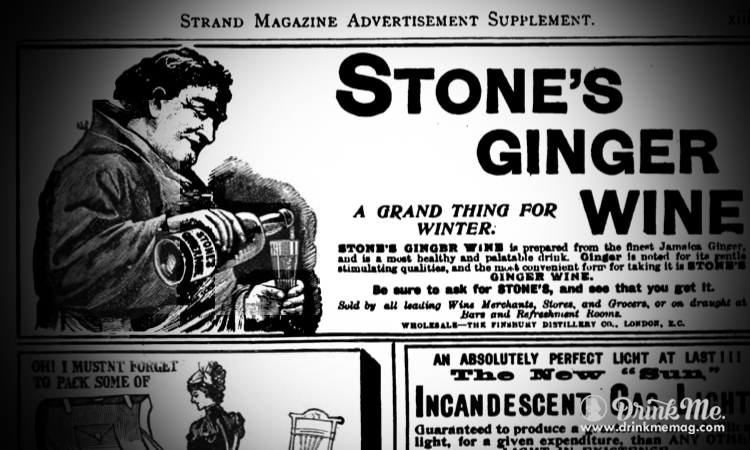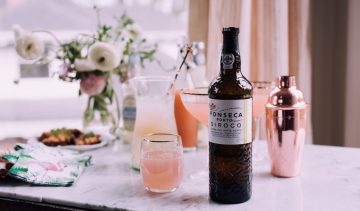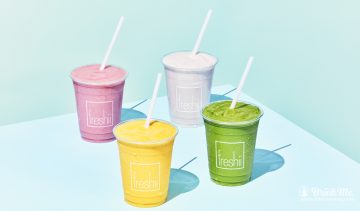As British traditions go, drinkable ginger is just about as prominent as Yeoman Warders or afternoon tea. In addition to ginger tea and ginger beer, for over 250 years British tipplers have quaffed a fermented ginger drink made from a blend of ginger, sugar, and raisins. It’s known as ginger wine or “green ginger wine.” Don’t let the name fool you though, the wine is actually golden brown in color—“green” refers to the color of the bottles traditionally used by Stone’s and Crabbie’s, the two leading British brands. Unlike ginger beer or ale, ginger wine is viscous and non-carbonated. Pour it into a cordial glass, and in the right lighting you might mistake it for madeira, or a very old sherry.
Technically, ginger wine is a product of fermentation, not distillation. However, its most well-known source is the Finsbury Distillery of London, which claims to have begun producing the Stone’s recipe (or something much like it) in 1740. Anglian enthusiasm for ginger wine dates back even further; an Elizabethan reference to ginger wine was recently unearthed and recipes began appearing at the turn of the eighteenth century. Britons sipped ginger wine as a digestive, as a Christmas holiday tradition, and, until the late eighteen hundreds, as a purported cure for cholera.
However, like Marmite, Footballers’ Wives, and Girls Aloud, success in America continues to elude ginger wine. Somewhere along the way—most likely during one of the more puritanical patches on our American quilt—we got it into our Yankee heads that all drinkable ginger should be revoltingly non-alcoholic. Case in point: the most popular ginger “ale” in America is Canada Dry, a booze-free soda made primarily from water and high fructose corn syrup, with a decidedly dispiriting name that connotes two things: the absence of alcohol, and the least spicy place on Earth. And while we Yanks have lately begun to consume ginger “beers” with a bit more heat to them—spicier sodas like Bundaberg from Australia or Reed’s from Jamaica—at the bar, our ginger most often comes at the end of a “whiskey and.” Stone’s has been available stateside for years, yet chances are you’ll find a bottle or two on the bottom shelf of your local beverage emporium, gathering dust.
Accolade Wines (the Australian conglomerate that recently acquired Stone’s—but refuses to sell it on the Australian continent) consistently sells eight to ten thousand cases of ginger wine per year in the United States. To put than number in perspective, in 2012 approximately sixteen thousand cases of Martini & Rossi sweet vermouth were sold in the State of Pennsylvania alone. Stone’s appeals most to American women over fifty in the Northeast. Oddly, the age of that cohort of ginger wine enthusiasts never changes—basically, with every generation several hundred newly middle-aged Connecticut ladies suddenly develop a fondness for Stone’s. Perhaps it is time for the rest of America to discover what those seasoned New England ladies are onto.
There are at least six reasons that ginger wine is the next big thing:
- Ginger wine is delicious. It delivers a mild dose of tingly, short-lived heat in a sweet and pleasantly boozy solution, complemented by a hints of holiday baking spices.
- It packs a punch. Stone’s weighs in at about 13.5% alcohol (27 proof), about the same as a Napa red.
- It’s cheap. In San Francisco, I paid less than $15 for a fifth of Stone’s.
- It was heralded by no less than the “father of American mixology,” Jerry Thomas. Who included a recipe for homemade ginger wine in the 1862 Bon Vivant’s Companion.
- Ginger promotes good health. Traditional beliefs claim that the spicy rhizome can reduce fatigue, cure migraines, ease menstrual symptoms, and placate coughs. Your mother and the Journal of Bioorganic & Medicinal Chemistry agree: ginger will settle a tempestuous stomach. If your upbringing was anything like mine, ginger ale—stirred, to remove the bubbles—was the only way to reintroduce your young stomach to the world of nourishment after a bout of the flu or food poisoning.
- Ginger wine is versatile. Like the American renaissances currently being enjoyed by vermouth and other fortified wines , it mixes well with either brandy or bourbon. Ginger wine is also a key ingredient in a criminally underappreciated cocktail, the Whisky MacDonald, or “Whisky Mac.”
The Whisky Mac is as simple and flexible as it gets: start with equal parts blended Scotch and ginger wine and adjust to taste. Take it on the rocks or served up. Garnish is optional, but a lemon slice doesn’t hurt. In her 2009 book How to Drink, Victoria Moore waxes poetic: “If you are the riding, shooting, or fishing type, a ginger wine or a whiskey mac—the British counterpart of the American bourbon and ginger—would be the best thing you could put in your hip flask. And even if you are not, it is probably worth taking yourself off on a long, lonely walk across some frozen, frosty fields to enjoy the vigorous spread of ginger’s heat either while you’re out or as a reward once back home.” She’s right. Hot Whisky Mac is an absolute godsend either in winter or when nursing a cold. Simply replace the ice with one to two ounces of boiling water and add the spices and citrus you’d otherwise dash into a toddy.
With one sip, you’ll understand England’s unabated enthusiasm for ginger wine. After a few more, you’ll start fantasizing about America’s wineries taking up the cause. If so, keep calm and carry on (drinking): Liliputian Winery, from Hotchkiss, Colorado, began making Shangri-La ginger wine in 2011. It’s great with sushi.
Hikers, hip-flask-ers, cold sufferers, and anyone who enjoys wine with sushi… Before too long, those middle-aged ladies from New England may have company as they browse the shelves of their local beverage emporium. Pour yourself a Whisky Mac, and you may be inclined to join us there.
Ginger Old-Fashioned
2 oz. bourbon or rye
1/2 oz. ginger wine
3/4 tsp. superfine sugar
1 dash Peychaud’s bitters
1 dash Angostura bitters
Combine sugar, bitters, and ginger wine in a wide-bottomed glass with an ice cube. Stir. Add more ice and whiskey. Stir again. Strain into a chilled rocks glass. Garnish with a lemon peel.
Buxom Cocktail by Ken Walczak
1 1/2 oz. Laird’s Bottled-in-Bond Straight Apple Brandy
1 oz. ginger wine
3/4 oz. yellow chartreuse
1 dash Fee Bros. Whiskey Barrel-Aged Bitters
Stir with cracked ice. Strain and serve up. Garnish with a thin apple slice and/or candied ginger.
Ginger Wine
From The Guardian UK, 5/9/12
About 5 inches / 12cm root ginger, peeled and finely sliced
5 litres (20 cups) of water
1.4kg (3 pounds) sugar
Zest and juice of 4 lemons
500g (3 cups, packed) raisins, chopped or squashed by putting in a carrier bag and pounding, or a 200ml can of white grape juice concentrate
1 sachet of white wine yeast
Yeast nutrient
Place the ginger in a plastic fermenting bucket, add the lemon zest and the raisins, then pour over 2.5 litres (or 10.5 cups) of boiling water. Cover and leave for 24 hours.
Boil and cool the remaining 2.5 litres (10.5 cups) of the water and add to the ginger infusion. Also add the sugar, lemon juice, and yeast nutrient and stir until the sugar is dissolved. Then add the yeast (follow the instructions on the packet). Cover and leave to ferment for three or four days then transfer into a demijohn using a sterilized sieve and funnel.
Fit a bubble trap and allow to ferment for a couple of months. Rack-off into a fresh demijohn and leave until clear, then bottle.













